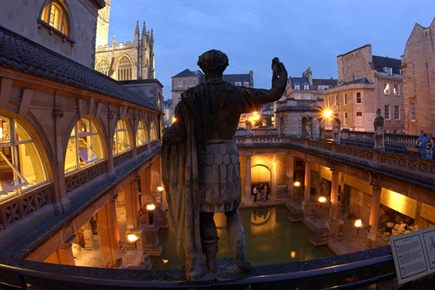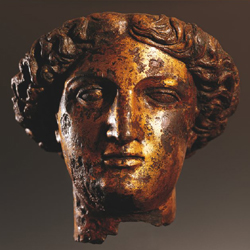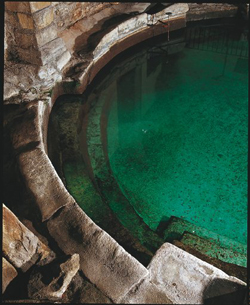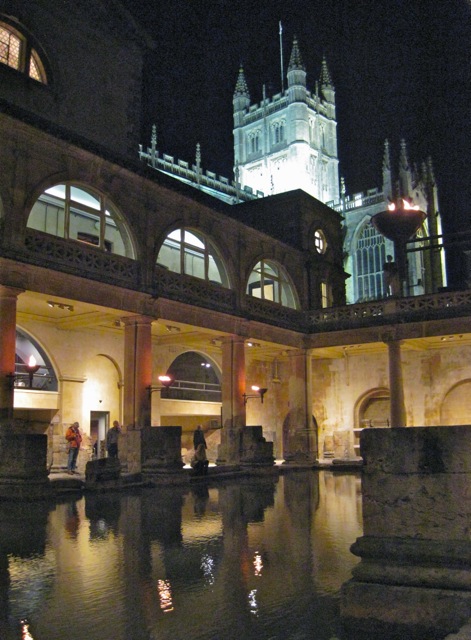
A statue of a Roman emperor peers down into the torch-lit main pool at Bath’s ancient Roman ruins. Photo courtesy Roman Baths
I’ve been to a lot of museums in my time—most fascinating, some grotesque, some silly—but Bath’s ancient Roman museum wins points for being romantic. During July and August, the Roman Baths stay open late and are lit by torches, which gives it that authentic 10 A.D. feel. With steam coming off the pool and a view of the nearby spires and pinnacles of Bath Abbey, it’s a sweetheart’s dream.
My husband and I visited the ancient baths right after experiencing another romantic venue in the city of Bath: the Spa Thermae, the modern equivalent of what the Romans built more than 2,000 years ago. The two of us were still glowing from spending a few hours submerged in the warm pools of water that have bubbled up from the ground for longer than human memory. When we entered the magical, after-dark atmosphere of the museum, we were greeted by statues of emperors flickering in the firelight. Below was the main pool, where the Romans soaked for health and relaxation.

Bath Abbey is beautifully lit at night, and it looks spectacular from the Roman baths. Photo© Ken Aikin
England’s Roman occupiers called this place Aquae Sulis, Latin for “The Waters of Sulis.” (Sulis was the Celtic goddess who reigned over the thermal spring, considered sacred.) The Romans associated Minerva, their goddess of wisdom and the arts, with Sulis the Celtic goddess. They built a temple, along with elaborate baths and steam rooms, dedicated to Sulis Minerva at the site of this sacred spring.
On our evening excursion, Ken and I felt like we were walking with the spirits of long-ago visitors who traveled from across the Roman Empire to take a dip in the healing, 114-degree water—just as we did. As we wandered through the museum, a few costumed interpreters demonstrated what life in this Roman outpost was like millennia ago.
The artifacts were beautiful: from coins that people threw in as offerings to the goddess to samples of inscribed curses that people left. The gilt-bronze head of Sulis Minerva is quite stunning. Her statue would have stood within her temple beside the Sacred Spring. I also loved the “Gorgon,” a man’s face, circled by flowing hair carved from Bath stone.
Despite all these treasures, the best part (for me) of visiting the Roman baths was sitting on the stones beside the central bath.
Surrounded by pillars and statues illuminated by flickers of torchlight, I dipped my hands into the warm water and watched the bubbles surface from deep within the earth. I could have been a woman enjoying the baths thousands of years ago. The evening was quiet, with only a few visitors in the last hour. Never has a history museum been so evocative.
The Rise of a Green Empire
For an ancient ruin, Bath’s Roman Baths are quite forward thinking. To be more sustainable and to reduce its carbon footprint, the museum:
- Uses energy from the hot spring to heat buildings.
- Relies on energy-efficient lighting, including floodlights that reduce energy consumption by 60 percent and LED lights on the Terrace and in the Reception Hall.
- Serves ethically sourced tea and coffee in the Pump Room.
- Cooks with local ingredients as much as possible.
- Uses recyclable paper bags and 100 percent biodegradable carrier bags in the shops.
- Is committed to recycling.
It’s nice to know that conservation of the past goes hand in hand with conservation of natural resources—so that we all have a future to look forward to.
—Laurel Kallenbach, freelance writer and editor
For more information on visiting the historic city of Bath, England—a UNESCO World Heritage site—refer to the Visit Bath website.
To read about what it’s like to soak in the natural mineral pools at Bath Spa Thermae, read my blog post about this modern spa.
Read more about my travels in England:
- Village-to-Village Walking in the Cotswolds: Day 1
- Walking in the Cotswolds Day 2: The Beautiful Slaughters
- New Uses for England’s Old Phone Booths
- Wandering the Venice of the Cotswolds: Bourton-on-Water
- Musings from Cotswold Trails (Day 3): Naunton & Guiting Power
- Winchcombe: This Cotswolds Village Is a Hub for Hiking
- Cottages in the Cotswolds: Old Minster Lovell
- My Pilgrimage to the Real Downton Abbey
- Bampton, England: Film Location for “Downton Abbey”
- King Tut Meets “Downton Abbey” at England’s Highclere Castle
- An Eco-Elegant English Hotel, “Downton Abbey” Style
- Sweet Dreams at “Downton Abbey”
- Touring England’s Ancient Roman Baths by Romantic Torchlight
- A Birthday among the Ancient Rocks of Stonehenge




Looks so pretty!